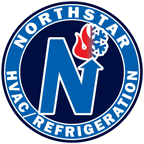Key Signs Your Rooftop HVAC Unit Needs Replacement
Written by Ed Rice
Rooftop HVAC units (RTUs) are essential for maintaining indoor comfort in commercial and industrial buildings. However, like all mechanical systems, they have a finite lifespan and will eventually require replacement. Waiting too long to replace an aging or failing RTU can result in higher energy costs, reduced efficiency, frequent breakdowns, and uncomfortable indoor conditions.
If you’re unsure whether your RTU is still operating at peak performance, here are key signs that it may be time for an upgrade.
1. Your Unit is Over 15-20 Years Old
Most RTUs have an average lifespan of 15 to 20 years, depending on maintenance and environmental factors. As units age, they lose efficiency, require more repairs, and become more costly to operate.
If your system is over 15 years old, it’s a good time to start planning for a replacement.
Newer high-efficiency models can cut energy consumption by 20-40%, making replacement a cost-effective decision in the long run.
2. Rising Energy Bills
A sudden increase in energy costs without a significant change in building usage could mean your RTU is working harder than it should. Older units often experience:
• Reduced efficiency due to wear and tear.
• Overcompensation for declining performance, leading to longer run times.
• Inability to maintain proper temperature control, increasing energy consumption.
New high-efficiency RTUs with variable speed drives and advanced controls can significantly lower energy costs while maintaining a comfortable indoor environment.
3. Frequent Repairs and Higher Maintenance Costs
An RTU that requires constant repairs is a strong indicator that it’s reaching the end of its lifespan. Common repair issues include:
• Compressor failures.
• Leaking refrigerant.
• Faulty motors or fan belts.
• Malfunctioning sensors and controls.
If repair costs are stacking up, it may be more cost-effective to invest in a new unit rather than continuing to service an outdated system.
4. Inconsistent Temperature Control and Poor Comfort Levels
Are some areas of your building too hot while others are too cold? An aging or inefficient RTU can struggle to distribute air evenly, resulting in uneven temperatures and discomfort for employees and customers.
Signs of declining performance include:
• Inconsistent cooling or heating throughout the building.
• Frequent thermostat adjustments to maintain comfort.
• Poor humidity control, leading to excessive dryness or moisture buildup.
Upgrading to a new RTU with smart sensors and zoning capabilities can improve airflow balance and climate control across your facility.
5. Excessive Noise or Strange Sounds
A rooftop unit should run relatively quietly, producing a steady hum during normal operation. If you hear grinding, banging, or rattling sounds, it could indicate:
• Loose or broken components.
• Failing bearings or belts.
• Compressor issues.
Loud noises often signal imminent mechanical failure, making it essential to address the issue before it results in a costly emergency repair.
6. Use of Outdated or Phased-Out Refrigerants
Many older RTUs still rely on R-22 refrigerant, which has been phased out due to environmental concerns. If your unit uses R-22 or other high-GWP refrigerants, replacing it with a system that uses low-GWP alternatives (such as R-32 or R-454B) can:
• Ensure compliance with new refrigerant regulations.
• Reduce long-term refrigerant costs, as older refrigerants become more expensive.
• Improve system efficiency while lowering carbon emissions.
7. Lack of Smart Controls and Energy Optimization Features
Modern RTUs come equipped with advanced controls and automation that allow for:
• Remote monitoring and diagnostics.
• Smart scheduling to optimize energy use.
• Zoning and temperature adjustments based on occupancy.
If your current system lacks energy-saving features, upgrading to a smart RTU can provide significant savings while improving overall system management.
Benefits of Replacing Your Rooftop HVAC Unit
Lower Energy Costs – New models use up to 40% less energy than outdated units.
Improved Reliability – Fewer breakdowns mean lower repair costs and less downtime.
Better Indoor Comfort – Consistent airflow and humidity control lead to better air quality.
Regulatory Compliance – Meets 2025 refrigerant regulations and new efficiency standards.
Incentives and Rebates – Many states offer rebates for energy-efficient HVAC upgrades.
How Northstar Refrigeration Can Help
At Northstar Refrigeration, we specialize in:
RTU Inspections and Efficiency Assessments – We evaluate your current system and recommend the best solution.
Energy-Efficient RTU Replacements – We install modern, high-performance rooftop units.
Smart Controls and Optimization – We integrate advanced controls for energy savings.
Refrigerant Transition Assistance – We help you navigate low-GWP refrigerant upgrades.
Thinking about replacing your RTU? Contact Northstar Refrigeration at (508) 888-3692 for an evaluation and customized upgrade plan.
Final Thoughts
Recognizing the signs of an aging or inefficient RTU can prevent costly repairs, improve energy efficiency, and enhance comfort in your facility. Whether you need a system upgrade or a full replacement, taking action now can save your business money and ensure compliance with upcoming regulations.
Is your RTU ready for an upgrade? Let Northstar Refrigeration help you transition to a more efficient and reliable system. Call us today to learn more about your options!
(508) 888-3692
www.northstarhvacr.com


